Time trials
Bad news for the likes of Chris Froome. Just two time trials in the 2015 Tour and they total no more than 42 kilometres. Stage 1 is a 13.7 kilometres individual time trial on a circuit in the streets of Utrecht, whilst stage 9 takes the riders in a team time trial of 28 kilometres on long straight roads from Vannes to Plumenec in Brittany. The finale of the TTT is the 1.7 kilometre climb up the Cote de Cadoudal.
The next day the first rest day welcomes the riders in Pau. Then it’s party time in the Pyrenees.
All in all, climbers are better endowed than time trialists with seven mountain stages and five mountain finishes. In stead of a time trial on the penultimate day, the 2015 Tour de France sees the final battle on the 21 hairpins of L’Alpe d’Huez
Echelons
But is all starts in the flatlands of Holland. After the ITT, stage 2 is a completely flat ride to Neeltje Jans on the Dutch coast. But with cross winds sparking echelons it could turn out to be a whole different ball game everyone expected. For instance not a massive bunch sprint, but a group of 50 riders battling for glory after the pack broke in pieces by the winds.
The next day we are in Belgium. The final part of stage 3 goes through the Ardennes to finish atop the Mur de Huy, notorious from La Fleche Wallone and ‘blessed’ with a double-digit gradient. GC men will be fighting for every second, especially since the bonification seconds are back in the Tour in the stages 2 through 8.
Stage 4 sees 13.3 kilometres of cobbles, once again bad news for Chris Froome. Title holder Vincenzo Nibali won’t mind, since he won precious time in last year’s ‘mini Paris-Roubaix’ of La Grande Boucle, whilst his now-teammate Lars Boom took the stage-win.
Stages 5, stage 6 and stage 7 are in northern France and should fancy the sprinters no matter what. The arrivals are in Amiens, Le Havre and Fougères.
In stage 8 it’s a finish atop of a Wall again, this time at the Mûr de Bretagne. The climb is 2 kilometres, with the first kilometre being steepest with a constant gradient of between 9.5% and 10.1%.
The last day before the first rest day brings the TTT.
Pyreneees
Bastille Day sees the first race in Pyrenees and in stage 10 riders head for La Pierre Saint Martin. The ride is mainly on the foothills but the finale brings a 15.3 kilometres climb, kicking in hard with a 8% plus gradient until 10 kilometres up the slopes.
Stage 11 takes the riders to Cauterets after cresting both Col d’Aspin and Col du Tourmalet.
The riders say goodbye to the Pyrenees in stage 12, leading to Plateau de Beille – a monster in the guise of a 15.8 kilometres climb at 7.9%. The climb is a constant toil wit hno moment to catch your breath. Earlier that day Col de Portet d’Aspet, Col de la Core and Port de Lers are on the menu.
Massif Central
The days after the Pyrenees the pack races the Massif Central, an elevated region with over four hundred extinct volcanoes in south-central france. Sprinters with climber’s legs – the Sagans, Matthews’ and Degenkolbs of this world – will have their say in the hilly terrain of stages 13, whilst puncheurs will be eyeing up stage 14. Finishing in Mende this one brings the third finish after climbing up a Wall. It’s 3 kilometres climb at an average gradient of 10.1%. Upon cresting it’s 1.7 kilometres to the finish line. Philippe Gilbert, perhaps?
Stage 15 is hilly at first, but closes with a flat section of 50 kilometres that should fancy the sprinters.
When arriving in Gap, as per usual the Tour de France celebrates escapees. Will this be the story in stage 16 again? Thor Hushovd and Rui Costa recently soloed to victory in the town in the foothills of the Alps.
The Alps
With stages to Pra Loup, Saint Jean de Maurienne, La Toussuire and the aforementioned L’Alpe d’Huez, the Alps are better represented than the Pyrenees.
Stage 17 brings the riders to 1.620 metres after a string of climbs closed with the Col d’Allos, at an elevation of 2.250 metres, and the ascent to ski-resort Pra Loup. The Allos is a 23.5 kilometres long drag at 4.3%. The downhill is nothing short of spectacular and then it’s up to Pra-Loup, a 9.4 kilometres climb with the final 6 kilometres being the toughest at a 8% grade.
Master piece of stage 18 is the Col du Glandon, a climb of nearly 50 kilometres, whilst the finale is the Lacets de Montvernier climb. With 18 hairpins in only 3.8 kilometres a serious risk to get giddy.
The last two Alpine stages are totaling only 248 kilometres. So that should detonate the fireworks from start to finish with stage 19 in just 138 kilometres and stage 20 in 110 kilometres.
Stage 19 brings the riders over Col de Chaussy, Col de Croix de Fer and Col de Mollard to finish atop at La Toussuire, a 18 kilometres climb at 6.1%.
In the final mountain stage to L’Alpe d’Huez, stage 20 offers GC riders a last chance to fight for a better overall. The decor is the flanks of this heroic 21 hairpins mountain!
Paris!
The closing stage to Paris is traditionally a feast for fast men like Cavendish and Kristoff. Riders who appreciate a good cigar are advised to be around Purito.
Tour de France 2015: Images and more
Click on the images to zoom
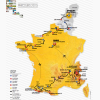
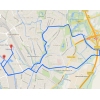
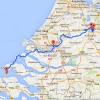
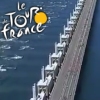




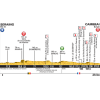
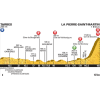
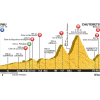
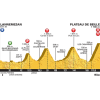
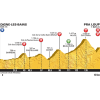
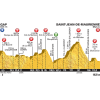
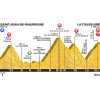
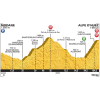
Very good presentation but I cannot find detailed information for each stage.
For instance I will be in the Langogne area but does the route go through this town or where?
Hey Chris,
the details information about the different stages will come soon, we are working on it.